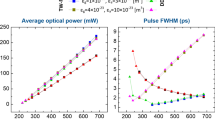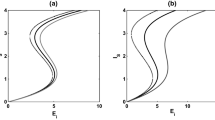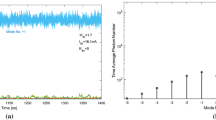Abstract
In this paper, we discuss the relations between the spatially-distributed traveling wave, Lang–Kobayashi, and a new multi-mode delay differential equation models for Fabry–Perot type semiconductor diode lasers with an external optical feedback. All these models govern the dynamics of the slowly varying complex amplitudes of the optical fields and carrier density. To compare the models, we calculate the cavity modes determined by the threshold carrier density and optical frequency of the steady states in all three models. These calculations show that the Lang–Kobayashi type model is in good agreement with the traveling wave model only in the small feedback from the external cavity regimes, whereas newly derived multi-mode delay differential equation model remains correct even at moderate and large optical feedback regimes.



Similar content being viewed by others
References
Arkhipov, R.M., Amann, A., Vladimirov, A.G.: Pulse repetition-frequency multiplication in a coupled cavity passively mode-locked semiconductor lasers. Appl. Phys. B 118, 539–548 (2015)
Bandelow, U., Radziunas, M., Sieber, J., Wolfrum, M.: Impact of gain dispersion on the spatio-temporal dynamics of multisection lasers. IEEE J. Quantum Electron. 37, 183–188 (2001)
Carroll, J.E., Whiteaway, J., Plumb, D.: Distributed Feedback Semiconductor Lasers. IEE, London (1998)
Engelborghs, K., Luzyanina, T., Samaey, G.: DDE-BIFTOOL v. 2.00: a Matlab package for bifurcation analysis of delay differential equations. Technical Report TW330, Katholieke Universiteit Leuven, Belgium (2001)
Jaurigue, L., Pimenov, A., Rachinskii, D., Schöll, E., Lüdge, K., Vladimirov, A.: Timing jitter of passively-mode-locked semiconductor lasers subject to optical feedback: a semi-analytic approach. Phys. Rev. A 92(5), 053807 (2015)
Lang, R., Kobayashi, K.: External optical feedback effects on semiconductor injection laser properties. IEEE J. Quantum Electron. 16, 347–355 (1980)
Radziunas, M., Wünsche, H.J., Krauskopf, B., Wolfrum, M. In: SPIE Proceedings Series, vol. 6184, p. 61840X (2006)
Radziunas, M., Tronciu, V.Z., Kürbis, C., Wenzel, H., Wicht, A.: Study of microintegrated external-cavity diode lasers: simulations, analysis, and experiments. IEEE J. Quantum Electron. 51, 2000408 (2015)
Schikora, S., Wünsche, H.J., Henneberger, F.: Odd-number theorem: optical feedback control at a subcritical Hopf bifurcation in a semiconductor laser. Phys. Rev. E 83, 026203 (2011)
Tronciu, V.Z., Mirasso, C.R., Colet, P., Hamacher, M., Benedetti, M., Vercesi, V., Annovazzi-Lodi, V.: Chaos generation and synchronization using an integrated source with an air gap. IEEE J. Quantum Electron. 46, 1840–1846 (2010)
Vladimirov, A.G., Turaev, D.: Model for passive mode locking in semiconductor lasers. Phys. Rev. A 72, 033808 (2005)
Author information
Authors and Affiliations
Corresponding author
Additional information
This article is part of the Topical Collection on Numerical Simulation of Optoelectronic Devices 2016.
Guest edited by Yuh-Renn Wu, Weida Hu, Slawomir Sujecki, Silvano Donati, Matthias Auf der Maur and Mohamed Swillam.
Appendix: Normalization of the TW model
Appendix: Normalization of the TW model
Before normalization, the TW model within the considered Fabry–Perot-type diode laser (longitudinal coordinate \({\tilde{z}}\in [-{\tilde{L}},0]\)) reads as in Bandelow et al. (2001):
whereas the boundary conditions for the optical fields are
The model parameters \(n_g\), g, \(n_{tr}\), \(\alpha\), \(\delta\), I, \(\sigma\), and \(\tau _N\) are the group velocity index, the differential gain, the carrier density at the transparency, the field losses, the detuning from the central frequency, the injected current, the cross-section area of the active zone, and the linear carrier recombination time, respectively. \(c_0\) and e are the physical constants denoting the speed of light in vacuum and the electron charge. Finally, \(\tilde{\phantom {a}}~\) indicates original non-normalized variables, coordinates, and parameters. In this paper, the detuning \(\delta\) is such that
where \(n_{th}\) and G are the threshold carrier density and threshold gain of the solitary diode laser, so that G represents full (radiative and non-radiative) losses of the laser in the absence of the feedback from the external cavity. This special choice of the detuning factor \(\delta\) implies the zero relative optical frequency of the solitary laser.
The normalization of the TW model is made by scaling the coordinates and the dynamical variables according to
where \({\varPsi }\) denotes \(E^+\), \(E^-\), \(P^+\), \(P^-\), \(F_e\) or \(F_i\). The parameters of the normalized TW model (3) are related to the parameters of the original model as
Rights and permissions
About this article
Cite this article
Radziunas, M. New multi-mode delay differential equation model for lasers with optical feedback. Opt Quant Electron 48, 470 (2016). https://doi.org/10.1007/s11082-016-0736-2
Received:
Accepted:
Published:
DOI: https://doi.org/10.1007/s11082-016-0736-2




